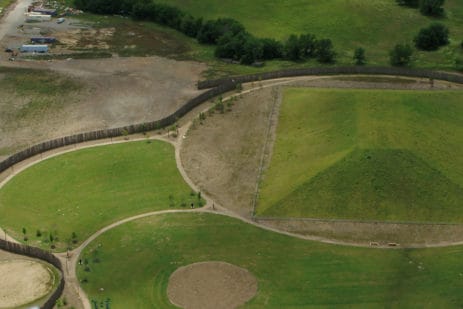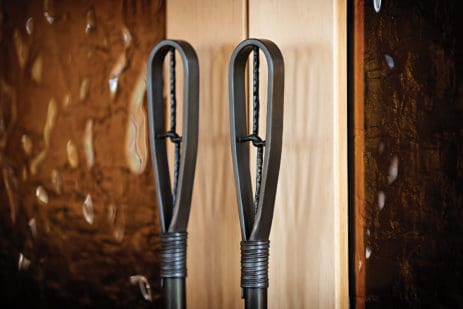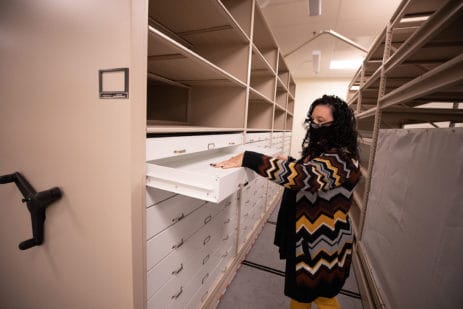Progress continues toward Cultural Center opening
Published November 1, 2020
By Chris Jennings
Construction continues on the 101,000 square foot Choctaw Cultural Center in Durant, despite the COVID-19 pandemic. Contractors and staff are at work, ensuring the Center is a place to preserve and teach visitors about the Choctaw culture.
The Center will be an immersive experience. Executive Director of the Cultural Center, Stacy Halfmoon, said, “You begin essentially at time immemorial, with Choctaw origin stories.”
Before entering the building, guests are treated to a ¾-mile drive highlighting native Oklahoma prairie land. The landscaping closer to the building was also carefully planted to continue this native prairie feel.
After visitors enter the building and go through the admissions desk, they will be presented with an orientation gallery that consists of 12 vignettes, one for each district. These allow for each community to tell their story of what life is like in Choctaw Nation today.
Moving from there, visitors travel through four different areas or landscapes designed to be fully experienced rather than read. The landscapes are in chronological order, with landscape one starting in the Mississippian era and going to pre-European contact.
Featured in this area is a cave from the Choctaw origin story and a large diorama of Moundville, which was located on the Black Warrior River in western Alabama.
Throughout the journey, guests will see several life casts made using living Choctaw tribal members that now represent their Choctaw ancestors telling stories in each vignette.
Landscape 2 is Shoma Takali (Hanging Moss) village from the 1700s. This area will represent the time after European contact and our government relations with the United States. A large display featuring several treaties between the U.S. and the Choctaw Nation is located in this area.
Here you’ll find a popular exchange between General Andrew Jackson from then Chief Pushmataha on display. General Jackson put on all his dignity and thus addressed the chief: “I wish you to understand that I am Andrew Jackson, and, by the Eternal, you shall sign that treaty as I have prepared it.” The mighty Choctaw chief was not disconcerted by this haughty address and springing suddenly to his feet and imitating the manner of his opponent, he replied, “I know very well who you are, but I wish you to understand that I am Pushmataha, head Chief of the Choctaws, and by the Eternal, I will not sign that treaty.”
All the treaties signed by the Choctaws eventually led to the Trail of Tears. Landscape 3 will tell the story of two different families during this time—the first family, who came in the 1830s, and another family in 1903. Visitors will have the opportunity to learn of the hardships during this time in three reflection galleries with content helping them visualize the Trail of Tears struggles.
Moving from this area, visitors will be presented with the final landscape, featuring the Choctaw Nation’s life in Oklahoma, including the successful rise to the present day and where the Nation wishes to be in the future. This area also contains the warrior gallery, representing the tvshka spirit and Choctaws’ long history of both men and women serving in the military.
After this, visitors can choose to move on to the Temporary Gallery, which will initially be an exhibit on Choctaw storytelling. This gallery will be changed periodically to tell different stories. “The changing exhibit gallery will give us an opportunity to rotate things in and highlight art and communities, to focus on particular elements in that space,” said Halfmoon.
Visitors can also go outside to see the living village and mound. If timed right, they may also be able to watch stickball on either the practice field or tournament field.
Throughout the building, guests can find symbolic touches that represent the Choctaw culture. From the stickball stick door handles to the beadwork light fixtures, every design element was carefully thought out to help convey the Choctaw experience.
“There’s not an element in the building or the exterior that wasn’t really thought through, that doesn’t have some kind of cultural significance. I think it says a lot about our staff and their knowledge and expertise,” said Halfmoon.
The Cultural Center will be a place that people can learn about what it means to be Choctaw or to discover their own Choctaw heritage. “There’s a lot of heart and soul in this building, and I hope everyone sees a little of themselves in the stories and exhibits and leaves feeling empowered,” said Cady Shaw, director of curation at the Cultural Center.
“It’s a significant investment the Choctaw Nation has made to build and develop this stunning Cultural Center. This means that Choctaw Nation will have a place to focus on perpetuating the culture, a place for guests and tribal citizens to come and learn about Choctaw culture and history, a place for classes, a place for presentations,” emphasized Halfmoon.
These areas of the Cultural Center make up roughly 90% of the building. The remaining 10% contains what could be considered the most important part: the collections and archive area. This area will be dedicated to Choctaw objects, artifacts and archival items.
Shaw said, “This will be the first of its kind for the Choctaw Nation and will set a high standard of care and preservation for some of the tribe’s most important historical and cultural documents and items.”
The collections spaces were constructed with the security and safety of its content in mind. Access can only be gained through biometric scanning devices, and the area itself was built to withstand an EF3 tornado. Inside the collections space is a blessing room and a freezer room for items that may have been involved in a flood or have pest contamination. There are also digitization, photography, wet and dry processing, archival and storage rooms.
Guests will have access to collections digitally through the Chahta Impona database in the Learning Lounge. This database will feature items at the Cultural Center as well as the Capitol Museum, Wheelock Historic Site and other institutions across the globe.
The database and on-site collections will make Choctaw Nation’s collections accessible to anyone who wishes to do tribal research.
“When someone wants to come in and perhaps do research, there would be a place for them to make an appointment and look at some of our archival documents related to the entire Choctaw experience. Whether that’s political history, treaties, family documents, allotment records or maps,” said Halfmoon.
As this eight-plus year journey nears this phase of completion, both Halfmoon and Shaw have high hopes for what the visitors may get from the Center.
“Personally, I really hope that anybody coming to the Choctaw Cultural Center sees that there is a living culture and that these are living people. That they feel that cultural spirit that is the Choctaw spirit, they see, they smell, they experience what they can of Choctaw culture,” said Halfmoon.
Shaw echoed that sentiment, “For community and tribal members, my greatest hope is they walk away proud. I would hope outside guests will come away feeling empowered with new knowledge and an affinity for Choctaw Nation. That they realize Choctaw Nation is alive, thriving and moving towards a bright future for everyone in Southeastern Oklahoma.”
Photos

Photo by Choctaw Nation
As guests enter the driveway leading to the Cultural Center they travel through native Oklahoma prairie land. The landscape around the building also continues this theme.

Photo by Choctaw Nation
The mound outside of the Cultural Center is a near duplicate of the mother mound, Nanih Waiya, in Mississippi. It is 39 feet tall, 420 feet long and 300 feet wide at the base, 192 feet long and 63 feet wide at the top. The mound is made up of 85,356 cubic yards of earth.

Photo by Deidre K. Elrod
Luksi waits to greet visitors to the children's area located inside the Cultural Center.

Photo by Choctaw Nation
Stickball stick door handles, the Cultural Center is full of meaningful cultural references.

Photo by Chris Jennings
All of the lifecasts in the Cultural Center were made using local Choctaw members. Bernie Davis served as a model for this one of a woman reading the Bible in landscape 2.



